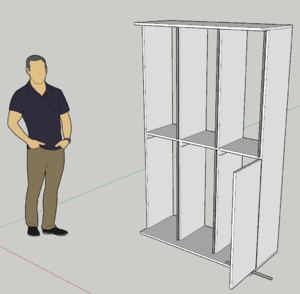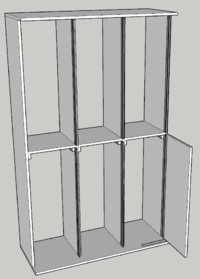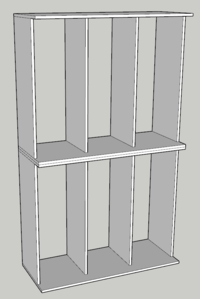Project:Lockers: Difference between revisions
From CoMakingSpace Wiki
m (→Horizontal Approach: wasted space - should be same height as other design) |
m (→Vertical Approach: tricky floor installation) |
||
| Line 25: | Line 25: | ||
* large contraption, difficult to transport later on | * large contraption, difficult to transport later on | ||
* cleats holding the floors waste a bit of space | * cleats holding the floors waste a bit of space | ||
* floors need to be secured from top and bottom to avoid tampering | |||
<br clear=left> | <br clear=left> | ||
== Horizontal Approach == | == Horizontal Approach == | ||
[[File:Horizontal approach.PNG|thumb|200 px|left|two horizontal boxes make up each six locker unit in this scenario]] | [[File:Horizontal approach.PNG|thumb|200 px|left|two horizontal boxes make up each six locker unit in this scenario]] | ||
Revision as of 14:19, 20 September 2017
| ProjectInfoBox building lockers for our members | |
|---|---|

| |
| Status: | in progress |
| Release Date: | Oct 2017 |
| Initiator: | Lukas, Ciaran, Patrick, Mitja |
| Team: | Ed |
| Materials Used: | plywood ("Elliotis pine"), wood screws, piano hinges, brackets |
| Tools Used: | circular saw, table saw, smoothing plane, sandpaper, cordless drill |
| Software Used: | SketchUp |
We are building a bunch of lockers for our common room!
Vertical Approach
The first prototype consisted of six lockers arranged in a 3 × 2 pattern, all in one frame.
pro:
- few individual boards
- pretty close to the minimum amount of wood needed for lockers this size
con:
- large boards to handle
- large contraption, difficult to transport later on
- cleats holding the floors waste a bit of space
- floors need to be secured from top and bottom to avoid tampering
Horizontal Approach
Ciaran proposed an alternative design during the making of the first "vertical" prototype which will be the second one we try.
pro:
- smaller individual boards
- smaller units - easier to move to a new location one day
- no space lost with cleats
con:
- more pieces to assemble
- "double floor" requires more wood and wastes more space than cleats would
Latch Hardware
Locking is possible by connecting the holes of a bracket and a matching piece of flat steel, e.g. with a padlock. Members can of course get creative and operate their locker with any number of over-engineered fancy setups ;-)

